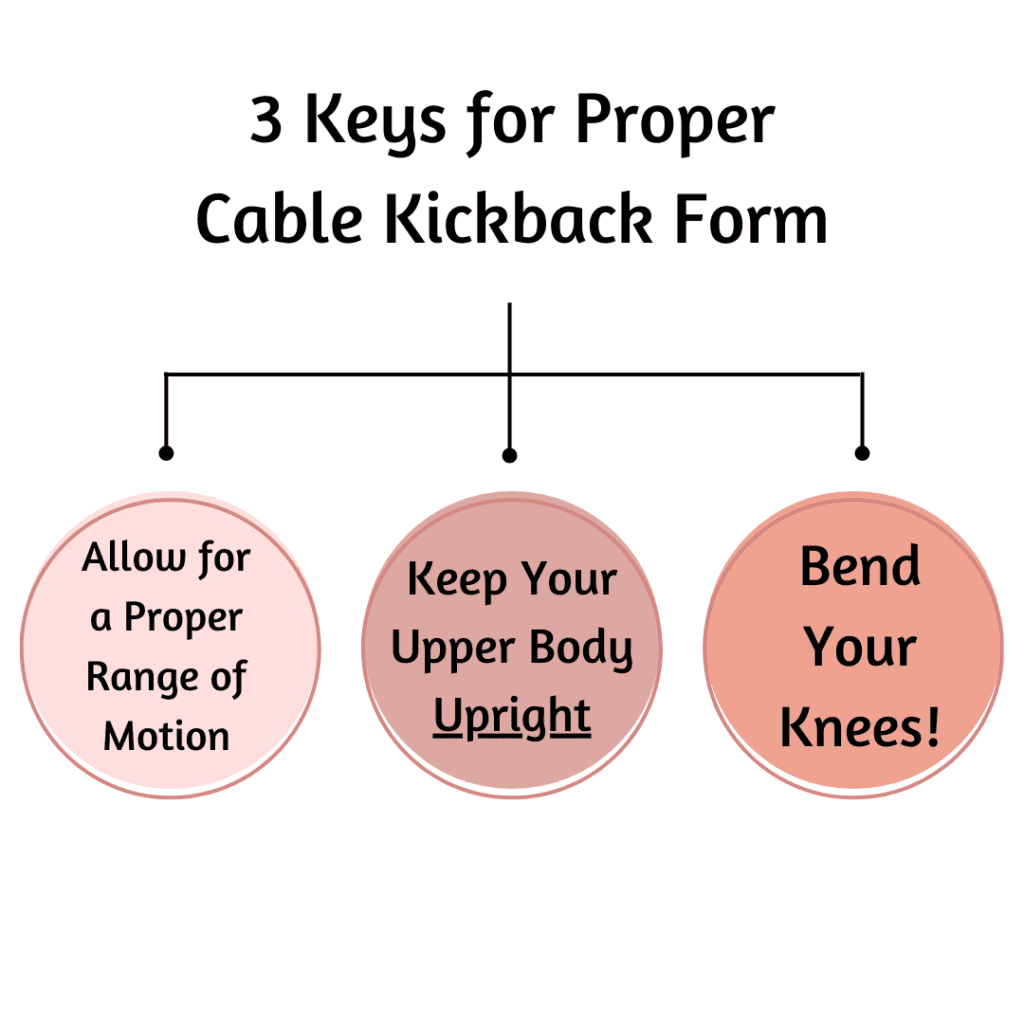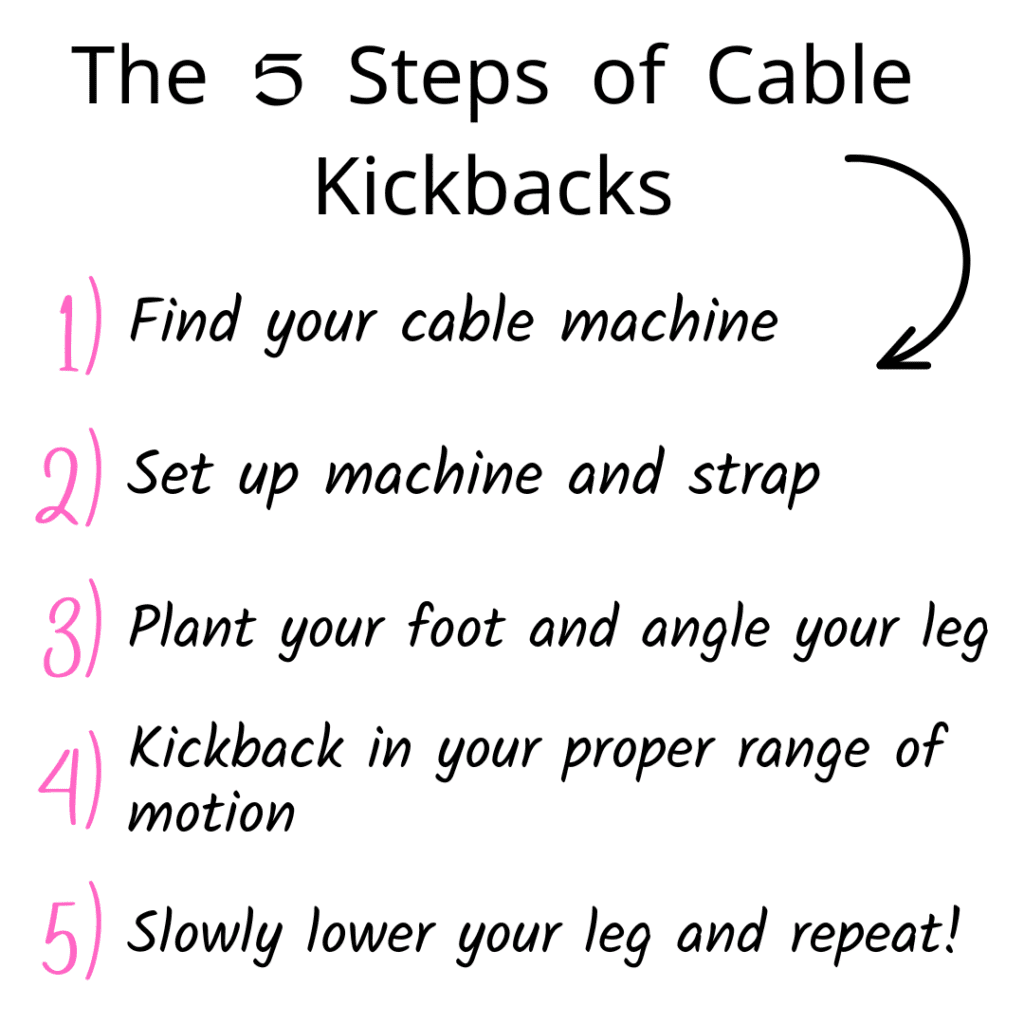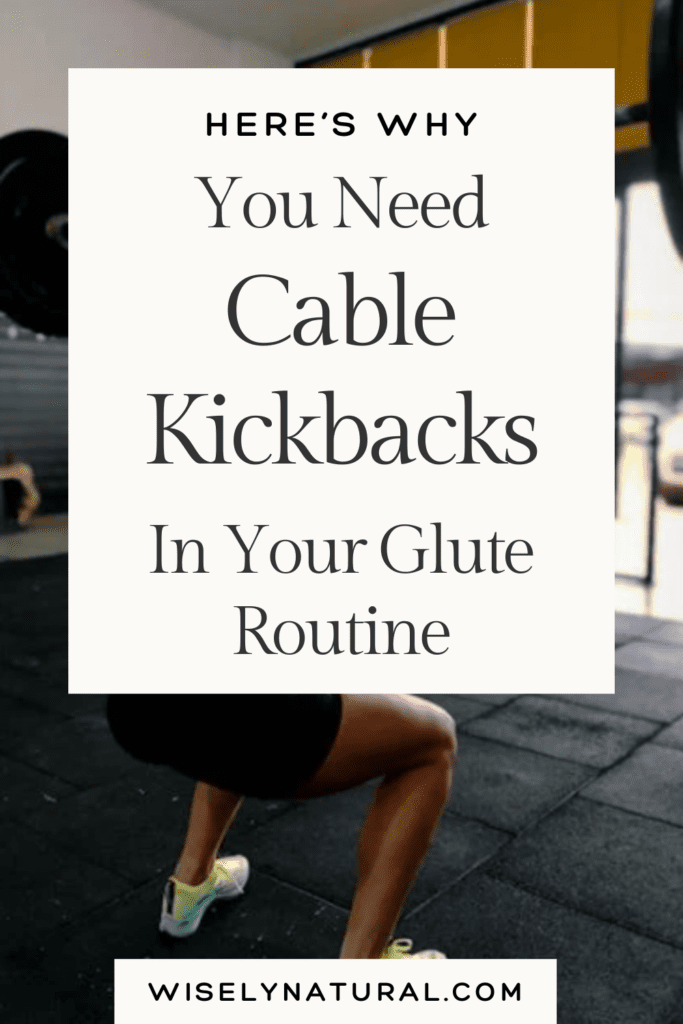As someone who’s a frequent gym goer, you’ve likely heard a recent increase in talk about glute cable kickbacks. And rightfully so.
Glute cable kickbacks are an excellent glute exercise that’s rising in popularity due to their effectiveness at targeting and stimulating glute growth.
However, in order to be most effective, perfecting your technique and form for this exercise is key.
Key to mastering the exercise and to seeing some serious glute growth!
In this post, I want to talk about everything you need to know to master your cable kickback technique and effectively grow your glutes in the gym.
In This Post You’ll Find:
A Step-By-Step Guide to Cable Kickbacks
The first step to learning how to do cable kickbacks is learning what perfect form for this exercise looks like.
As with any exercise in the gym, proper form is extremely essential. Without proper form, you significantly decrease your probability of muscle growth as well as decrease your chances of progressing with the exercise.
All while simultaneously increasing your risk for workout-related injuries!
As you might imagine, this is a recipe for disaster!
Although mastering proper cable kickback form can be a little tricky, it’s certainly worth the investment.
Proper Form Tips for Effective Cable Kickbacks:
1. Avoid kicking your working leg back too far and arching your back.
Doing this will take the tension off of your glutes and put it onto your lower back, decreasing the effectiveness of the exercise.
2. Keep your upper body more upright, with only a slight tilt forward.
Bending too far forward will decrease the amount of tension put on to your glutes during the exercise.
3. Allow for a slight bend in your working leg and your plant foot.
Incorporating a slight bend in your working leg helps your leg move through a better range of motion to target your glutes.
Bending the leg of your plant foot helps you stabilize and successfully complete each rep.

5 Simple Steps to Perform Effective Cable Kickbacks:
1. Find a cable machine and a strap for your ankle.
2. Lower the cable machine all the way to the ground, attaching the strap to the cable.
3. Wrap the strap around your ankle of your first working leg. This is the leg you’ll be kicking back. Your opposite leg (the one not attached to the machine) will be your plant foot.
4. Keep your plant foot planted beneath your body, pointing at a 45 degree angle across your body.
5. Kick your working leg back behind you at a 45 degree angle away from your body. Pause for a hold at the top, then slowly and with control, lower your leg back down to the starting position.

The Role of a Mind to Muscle Connection in Your Glute Exercises:
One key to mastering and perfecting any glute exercise in the gym is to develop a glute mind to muscle connection.
Once you begin developing a mind to muscle connection in your glutes, you’ll become much better at actually feeling every glute exercise you do, in your glutes.
You know when you’re trying to do an exercise for your glutes but can only feel it in your quads? Yeah, that won’t happen anymore.
This not only makes your glute workouts more fun, since you can actually feel your glutes working, it also makes them tremendously more effective.
Seriously, once you develop a mind to muscle connection in your glutes, you’ll start seeing and feeling glute growth like never before.
Top Reasons to Implement Cable Kickbacks into Your Glute Routine

Cable Kickbacks are an Effective Glute Isolation Exercise
You’ve most likely heard of compound exercises and isolation exercises in the gym, but you still might not be sure about what they mean exactly.
There’s really just one major difference you should know between these two types of exercises in the gym.
Whereas compound exercises are meant to target multiple muscle groups at once, isolation exercises primarily only target one muscle group at a time.
And with only one main muscle group working, you can really target and isolate that muscle you’re training.
Cable kickbacks just happen to be an excellent glute isolation exercise.
They primarily only work your glute muscles and actually only work one glute muscle at a time.
This allows to focus even more on the glute muscles you’re training. Allowing you to get a huge stretch and really hone in on growing your glutes.
Cable Kickbacks Target and Grow Your Upper Glutes
Many people might not know this, but your glutes are made up of three major muscle groups:
The glute maximus – This is the central, largest portion of your glutes.
The glute minimus – Smaller than the glute maximus, this is the lower portion of your glutes.
And finally the glute medius – This is the smallest portion of your glutes and is your upper glute muscle.
Of these three portions of your glutes, your glute medius is the hardest portion to target.
Because of this, your upper glutes are one the the trickiest portions of your glutes to grow.
There are two major reasons for this:
Reason number one is because the glute medius is the smallest portion of your glutes.
When you’re lifting heavy, your bigger, stronger glute muscles will immediately take over lifting the weight.
And reason number two is because your glute medius engages during very specific movements.
The best movements to target your glute medius are unilateral exercises where your working leg elevates in the path across your body.
But not many typical glute exercises in the gym follow this path of movement.
Glute kickbacks mimic this same motion, only working in the path behind your body instead of in front of it.
Making them one of the few exercises to successfully target and isolate your upper glutes.
Why Growing Your Glute Medius is Essential in Your Glute Routine
I’ve talked so much about cable kickbacks and how they isolate and grow your upper glutes.
But I haven’t talked at all about why it’s so important to grow your upper glutes.
What role does your glute medius play in your gym results?
Well, your glute medius is one of the most essential muscles to build to grow the shape of your glutes.
And building shape also gives the appearance of growing in size.
For example, you might have heard all over social media about growing a “shelf”.
There’s all this talk about growing the shelf to make your glutes appear more round, fuller, and bigger.
Well this shelf is your upper glutes, and it’s built from growing your glute medius!
Your Glute Medius is Essential for the Appearance of Your Glutes
While your glute medius doesn’t play the most significant role in the size of your glutes (your glute maximus does) it certainly plays one of the biggest roles in the appearance of your glutes.
Your upper glutes are what give you that rounder, larger, more lifted appearance that everyone’s looking for.
That’s why it’s possible to constantly be training your glutes and doing traditional glute growth exercises, and yet your glutes still don’t appear the way you want them to.
That’s because not all glute exercises target your glute medius. In fact, most of them don’t.
It’s possible to have large glute muscles but a small or weak glute medius.
And that’s what’s causing your glutes to appear smaller and flatter than they actually are, especially up top.
But by growing the glute muscles just below your lower back (your glute medius), you create the appearance of bigger, rounder, more lifted glutes.
Common Glute Cable Kickback Mistakes to Avoid for Effective Glute Growth
Below are some of the biggest mistakes women make when trying to perform glute cable kickbacks.
By avoiding these mistakes, you increase your chances and potential for progress. As well as keep the exercise as effective as it can be.
Trying to Lift a Weight That’s too Heavy
I’ve definitely talked about this before, but as with any exercise, lifting too heavy causes bigger, stronger muscles to overpower smaller, weaker muscles.
With your glute medius being the smallest muscle of your glutes (and typically the weakest) it’s easy to lift too heavy.
Easy in the sense that it’s common to overestimate the strength of your glute medius and lift a weight that this muscle can’t control on it’s own.
Causing your hamstrings, hips, and back muscles to step in and take control of the exercise.
The easiest way to avoid this is to start at an extremely low weight and practice engaging your glute medius while perfecting the glute kickback motion.
Continue increasing the weight until you get to the highest weight where you can maintain form, control, and connection in your glute medius.
Over-Extending Your Working Leg (Kicking Back too Far)
When doing cable kickbacks, there’s a very specific path that your leg needs to move through to keep maximum tension while also getting a maximum stretch on your glutes.
That’s why if you over-extend your leg behind you, you’ll take the tension off of your glutes and won’t get this maximum stretch.
You don’t want to kick your leg back so far that your glutes over contract and your back arches.
Once this happens, your back starts to engage and carry the weight. All at one of the most important parts of the exercise.
To avoid this happening, kick your leg back only to the point where you don’t need to bend forward any more or arch your back.
Rushing Through the Movement (Not Utilizing Time Under Tension)
In order for this exercise to be most effective, it’s essential that you slow down the exercise.
Specifically, you want to focus on increasing your time under tension during the eccentric portion of the exercise.
The eccentric portion of glute cable kickbacks is the portion of the exercise after the squeeze and hold at the top, where you’re lowering your leg back down to the starting position.
You want to focus on slowly lowering your leg back to the starting position and getting a maximum stretch and lengthening on your glutes.
Allow your foot to come all the way back down across the front of your body. This is where you’ll get the most stretch on your glutes and activate the most muscle growth in your glute medius.
Takeaways
Glute cable kickbacks have had a recent rise in popularity, and for good reason!
Cable kickbacks are one of the best glute isolation exercises to effectively isolate and grow your upper glutes.
For many of us trying to grow and create the appearance of lifted, rounder glutes, that’s exactly what we need!
Start implementing cable kickbacks into your glute routine today, and I promise you your results will thank you.
More of My Posts on Women’s Fitness and Weightlifting:
How to Actually Start Feeling Glute Exercises in Your Glutes
Here’s Why Doing More in The Gym Isn’t Always Better [And What to Do Instead]